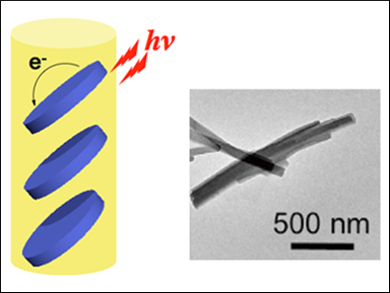In the preparation of supramolecular systems, self-assembly directed by non-covalent interactions has many advantages over the laborious multistep synthesis of many covalent bonds. Such a supramolecular strategy is thus promising for construction of ordered molecular assemblies.
Taku Hasobe, Shunichi Fukuzumi, and colleagues, Keio and Osaka Universities, Japan, have successfully constructed one-dimensional supramolecular nanoarrays of light-harvesting electron-donor units and electron acceptor units connected through triple hydrogen bounds. These systems, comprising 4-(2,4-diamino-1,3,5-triazinyl)phenyl-substituted zinc porphyrins as the donor and NH maleimide-substituted benzo[ghi]perylenetriimides as the acceptor, afforded columnar phases for photoinduced electron transfer.
Femtosecond transient absorption and electron spin resonance (ESR) measurements on the assemblies of these molecules confirmed that the ultrafast photoinduced electron transfer took place between zinc porphyrin and benzo[ghi]perylenetriimides in the columns. This method for molecular organization provides a new perspective for the development of photocatalytic and photovoltaic systems.
- Photoinduced Processes of Supramolecular Nanoarrays Composed of Porphyrin and Benzo[ghi]perylenetriimide Units through Triple Hydrogen Bonds with One-Dimensional Columnar Phases,
Taku Hasobe, Hayato Sakai, Kei Ohkubo, Shunichi Fukuzumi,
Chem. Asian J. 2016.
DOI: 10.1002/asia.201501367




